Knowledge-Mapping Analysis of Urban Sustainable Transportation Using CiteSpace
Abstract
1. Introduction
2. Methodology
2.1. Data Collection
2.2. Research Design
2.3. Data Analysis
2.3.1. Publication Output Analysis
Initial Stage (1991–1995)
Development Stage (1996–2010)
Rapid Growth Stage (2011–30 September 2022)
2.3.2. Keyword Co-Occurrence Analysis
2.3.3. Category Co-Occurrence Analysis
2.3.4. Co-Citation Network Structure Analysis
3. Network Structure Analysis
3.1. Co-Authorship Network Structure
3.2. Co-Affiliation Network Structure
3.3. Co-Country Network Structure
3.4. Co-Term Network Structure
4. Research Themes
4.1. Theme 1: Land Development and Utilization
4.2. Theme 2: Sustainable Planning and Layout of Transportation System
4.3. Theme 3: Low-Carbon Paths
4.4. Theme 4: Public Transport
4.5. Theme 5: Electric Vehicles
4.6. Theme 6: Sharing Mode
4.7. Theme 7: Traveler Behavior
4.8. Theme 8: Smart City
5. Research Dynamics and Recommendations for Future Research
5.1. Keyword Evolution and Research Trends
5.2. Category Evolution and Research Trends
5.3. Term Evolution and Research Trends
6. Conclusions
Author Contributions
Funding
Institutional Review Board Statement
Informed Consent Statement
Data Availability Statement
Conflicts of Interest
References
- Chang, H.L.; Chen, P.C. Exploring senior officials’ policy beliefs regarding sustainable transportation. Transp. Res. Part D-Transp. Environ. 2009, 14, 249–254. [Google Scholar] [CrossRef]
- Behbahani, H.; Nazari, S.; Kang, M.J.; Litman, T. A conceptual framework to formulate transportation network design problem considering social equity criteria. Transp. Res. Part A-Policy Pract. 2019, 125, 171–183. [Google Scholar] [CrossRef]
- Epicoco, N.; Falagario, M. Decision support tools for developing sustainable transportation systems in the EU: A review of research needs, barriers, and trends. Res. Transp. Bus. Manag. 2022, 43, 100819. [Google Scholar] [CrossRef]
- Ibitayo, O.O. Towards effective urban transportation system in Lagos, Nigeria: Commuters’ opinions and experiences. Transp. Policy 2012, 24, 141–147. [Google Scholar] [CrossRef]
- Banister, D.; Watson, S.; Wood, C. Sustainable cities: Transport, energy, and urban form. Environ. Plan. B-Plan. Des. 1997, 21, 125–143. [Google Scholar] [CrossRef]
- Lee, S.E.; Quinn, A.D.; Rogers, C.D.F. Advancing city sustainability via Its systems of flows: The urban metabolism of birmingham and Its hinterland. Sustainaility 2016, 8, 220. [Google Scholar] [CrossRef]
- Jiao, L.D.; Wu, F.Y.; Luo, F.L.; Zhang, Y.; Huo, X.S. Energy and environmental efficiency evaluation of transportation systems in China’s 255 cities. Front. Environ. Sci. 2022, 10, 950562. [Google Scholar] [CrossRef]
- Kenworthy, J.R.; Laube, F.B. Automobile dependence in cities: An international comparison of urban transport and land use patterns with implications for sustainability. Environ. Impact Assess. Rev. 1996, 16, 279–308. [Google Scholar] [CrossRef]
- Tabara, J.D. Sustainable transport, environmental quality and social structure. Urban Transp. Environ. II 1996, 26, 523–533. [Google Scholar]
- Prades, J.A.; Waaub, J.R. Cities, environment and development: An integrative societal approach toward a sustainable transport system. Urban Transp. Environ. II 1996, 26, 15–24. [Google Scholar]
- Baccini, P. Understanding regional metabolism for a sustainable development of urban systems. Environ. Sci. Pollut. Res. 1996, 3, 108–111. [Google Scholar] [CrossRef] [PubMed]
- Kennedy, C.A. A comparison of the sustainability of public and private transportation systems: Study of the Greater Toronto Area. Transportation 2002, 29, 459–493. [Google Scholar] [CrossRef]
- Ryan, S.; Throgmorton, J.A. Sustainable transportation and land development on the periphery: A case study of Freiburg, Germany and Chula Vista, California. Transp. Res. Part D-Transp. Environ. 2003, 8, 37–52. [Google Scholar] [CrossRef]
- Black, W.R. Sustainable transportation: A US perspective. J. Transp. Geogr. 1996, 4, 151–159. [Google Scholar] [CrossRef]
- El-Diraby, T.E.; Abdulhai, B.; Pramod, K.C. The application of knowledge management to support the sustainable analysis of urban transportation infrastructure. Can. J. Civ. Eng. 2005, 32, 58–71. [Google Scholar] [CrossRef]
- Gossling, S.; Nicolosi, J.; Litman, T. The health cost of transport in cities. Curr. Environ. Health Rep. 2021, 8, 196–201. [Google Scholar] [CrossRef] [PubMed]
- Haghshenas, H.; Vaziri, M. Urban sustainable transportation indicators for global comparison. Ecol. Indic. 2012, 15, 115–121. [Google Scholar] [CrossRef]
- Alonso, A.; Monzon, A.; Cascajo, R. Comparative analysis of passenger transport sustainability in European cities. Ecol. Indic. 2015, 48, 578–592. [Google Scholar] [CrossRef]
- ECMT (European Conference of Ministers of Transport). ECMT Programme of Work: Report; OCED Publishing: Paris, France, 2004. [Google Scholar]
- Lejda, K.; Mądziel, M.; Siedlecka, S.; Zielińska, E. The future of public transport in light of solutions for sustainable transport development. Sci. J. Sil. Univ. Technol. Ser. Transp. 2017, 95, 97–108. [Google Scholar] [CrossRef]
- Chen, C.M.; Song, M. Visualizing a field of research: A methodology of systematic scientometric reviews. PLoS ONE 2019, 14, e0223994. [Google Scholar] [CrossRef]
- Chen, C.M. Science Mapping: A systematic review of the literature. J. Data Inf. Sci. 2017, 2, 1–40. [Google Scholar] [CrossRef]
- Hare, B. Environmental-impact assessment-broadening the framework. Sci. Total Environ. 1991, 108, 17–32. [Google Scholar] [CrossRef]
- Hensher, D.A. Socially and environmentally appropriate urban futures for the motor car. Transportation 1993, 20, 1–19. [Google Scholar] [CrossRef]
- Hall, P. The future of planning. Mitt. Osterreichischen Geogr. Ges. 1994, 136, 37–52. [Google Scholar]
- Berry, G.D.; Pasternak, A.D.; Rambach, G.D.; Smith, J.R.; Schock, R.N. Hydrogen as a future transportation fuel. Energy 1996, 21, 289–303. [Google Scholar] [CrossRef]
- Lindquist, E. Moving toward sustainability—Transforming a comprehensive land use and transportation plan. Land Use Transp. Plan. Program. Appl. 1998, 1617, 1–9. [Google Scholar] [CrossRef]
- Hall, P. The future of the metropolis and its form. Reg. Stud. 1997, 31, 211–220. [Google Scholar] [CrossRef]
- Southworth, F. On the potential impacts of land use change policies on automobile vehicle miles of travel. Energy Policy 2001, 29, 1271–1283. [Google Scholar] [CrossRef]
- Herala, N. Regulating traffic with land use planning. Sustain. Dev. 2003, 11, 91–102. [Google Scholar] [CrossRef]
- Loo, B.P.Y.; Lam, W.W.Y. Commuting cost in Hong Kong: A multi-group comparison. Transp. Geogr. 2009, 1, 85–93. [Google Scholar]
- Keblowski, W.; Bassens, D. “All transport problems are essentially mathematical”: The uneven resonance of academic transport and mobility knowledge in Brussels. Urban Geogr. 2018, 39, 413–437. [Google Scholar] [CrossRef]
- He, C.F.; Huang, Z.J.; Wang, R. Land use change and economic growth in urban China: A structural equation analysis. Urban Stud. 2014, 51, 2880–2898. [Google Scholar] [CrossRef]
- Rabbitt, N.; Ghosh, B. Economic and environmental impacts of organised car sharing services: A case study of Ireland. Res. Transp. Econ. 2016, 57, 3–12. [Google Scholar] [CrossRef]
- Gomes, R.; Sousa, J.P.; Dias, T.G. Sustainable demand responsive transportation systems in a context of austerity: The case of a portuguese city. Res. Transp. Econ. 2015, 51, 94–103. [Google Scholar] [CrossRef]
- Iliopoulou, C.; Kepaptsoglou, K. Robust electric transit route network design problem (RE-TRNDP) with delay considerations: Model and application. Transp. Res. Part C Emerg. Technol. 2021, 129, 103255. [Google Scholar] [CrossRef]
- Gohar, A.; Nencioni, G. The role of 5G technologies in a smart city: The case for intelligent transportation system. Sustainability 2021, 13, 5188. [Google Scholar] [CrossRef]
- Awasthi, A.; Chauhan, S.S.; Omrani, H. Application of fuzzy TOPSIS in evaluating sustainable transportation systems. Expert Syst. Appl. 2011, 38, 12270–12280. [Google Scholar] [CrossRef]
- Rajak, S.; Parthiban, P.; Dhanalakshmi, R. Sustainable transportation systems performance evaluation using fuzzy logic. Ecol. Indic. 2016, 71, 503–513. [Google Scholar] [CrossRef]
- Meng, F.X.; Liu, G.Y.; Yang, Z.F.; Casazza, M.; Cui, S.; Ulgiati, S. Energy efficiency of urban transportation system in Xiamen, China. Appl. Energy 2017, 186, 234–248. [Google Scholar] [CrossRef]
- Tang, J.Q.; Heinimann, H.; Han, K.; Luo, H.B.; Zhong, B.T. Evaluating resilience in urban transportation systems for sustainability: A systems-based Bayesian network model. Transp. Res. Part C-Emerg. Technol. 2020, 121, 102840. [Google Scholar] [CrossRef]
- Gutierrez, L.R.; Oliva, M.A.D.; Romero-Ania, A. Economic, ecological and social analysis based on DEA and MCDA for the management of the Madrid Urban Public Transportation System. Mathematics 2022, 10, 172. [Google Scholar] [CrossRef]
- Ma, Y.; Lan, J.; Thornton, T.; Mangalagiu, D.; Zhu, D.J. Challenges of collaborative governance in the sharing economy: The case of free-floating bike sharing in Shanghai. J. Clean. Prod. 2018, 197, 356–365. [Google Scholar] [CrossRef]
- Chen, H.R.; Zhou, R.Y.; Chen, H.; Lau, A. Static and dynamic resilience assessment for sustainable urban transportation systems: A case study of Xi‘an, China. J. Clean. Prod. 2022, 25, 368. [Google Scholar] [CrossRef]
- Lehmann, S. Low-to-no carbon city: Lessons from western urban projects for the rapid transformation of Shanghai. Habitat Int. 2013, 37, 61–69. [Google Scholar] [CrossRef]
- Zong, F.; He, Y.N.; Yuan, Y.X. Dependence of parking pricing on land use and time of day. Sustainability 2015, 7, 9587–9607. [Google Scholar] [CrossRef]
- Godzisz, K.; Dzikuc, M.; Kulyk, P.; Piwowar, A.; Kurylo, P.; Szufa, S. Selected determinants of sustainable transport in the context of the development of a low-carbon economy in Poland. Energies 2021, 14, 5418. [Google Scholar] [CrossRef]
- Hartog, H.; Sengers, F.; Xu, Y.; Xie, L.J.; Jiang, P.; Jong, M. Low-carbon promises and realities: Lessons from three socio-technical experiments in Shanghai. J. Clean. Prod. 2018, 181, 692–702. [Google Scholar] [CrossRef]
- Dong, D.; Duan, H.B.; Mao, R.C.; Song, Q.B.; Zuo, J.; Zhu, J.S.; Wang, G.; Hu, M.W.; Dong, B.Q.; Liu, G. Towards a low carbon transition of urban public transport in megacities: A case study of Shenzhen, China. Resour. Conserv. Recycl. 2018, 134, 149–155. [Google Scholar] [CrossRef]
- Shukla, P.R.; Dhar, S. Energy policies for low carbon sustainable transport in Asia. Energy Policy 2015, 81, 170–175. [Google Scholar] [CrossRef]
- Jacob, P. Information and communication technology in shaping urban low carbon development pathways. Curr. Opin. Environ. Sustain. 2018, 30, 133–137. [Google Scholar] [CrossRef]
- Mehmood, U. Transport energy consumption and carbon emissions: The role of urbanization towards environment in SAARC region. Integr. Environ. Assess. Manag. 2021, 17, 1286–1292. [Google Scholar] [CrossRef] [PubMed]
- Liu, J.L.; Zhu, Y.; Zhang, Q.; Cheng, F.Y.; Hu, X.; Cui, X.H.; Zhang, L.; Sun, Z.L. Transportation carbon emissions from a perspective of sustainable development in major cities of Yangtze River Delta, China. Sustainability 2021, 13, 192. [Google Scholar] [CrossRef]
- Philp, M.; Taylor, M.A.P. Research agenda for low-carbon mobility: Issues for new world cities. Int. J. Sustain. Transp. 2017, 11, 49–58. [Google Scholar] [CrossRef]
- Kickhofer, B.; Agarwal, A.; Nagel, K. Mind the price gap: How optimal emission pricing relates to the EU CO2 reduction targets. Int. J. Sustain. Transp. 2019, 13, 378–391. [Google Scholar] [CrossRef]
- Zhang, R.S.; Zhang, J.Y. Long-term pathways to deep decarbonization of the transport sector in the post-COVID world. Transp. Policy 2021, 110, 28–36. [Google Scholar] [CrossRef]
- Selvakkumaran, S.; Limmeechokchai, B. Low carbon society scenario analysis of transport sector of an emerging economy-the AIM/enduse modelling approach. Energy Policy 2015, 81, 199–214. [Google Scholar] [CrossRef]
- Cheng, Y.H.; Chang, Y.H.; Lu, I.J. Urban transportation energy and carbon dioxide emission reduction strategies. Appl. Energy 2015, 157, 953–973. [Google Scholar] [CrossRef]
- Gupta, D.; Garg, A. Sustainable development and carbon neutrality: Integrated assessment of transport transitions in India. Transp. Res. Part D-Transp. Environ. 2020, 85, 102474. [Google Scholar] [CrossRef]
- Argyriou, I.; Barry, J. The political economy of socio-technical transitions: A relational view of the state and bus system decarbonization in the United Kingdom. Energy Res. Soc. Sci. 2021, 79, 102174. [Google Scholar] [CrossRef]
- Nocera, S.; Tonin, S.; Cavallaro, F. Carbon estimation and urban mobility plans: Opportunities in a context of austerity. Res. Transp. Econ. 2015, 51, 71–82. [Google Scholar] [CrossRef]
- Sudmant, A.; Colenbrander, S.; Gouldson, A.; Chilundika, N. Private opportunities, public benefits? The scope for private finance to deliver low-carbon transport systems in Kigali, Rwanda. Urban Clim. 2017, 20, 59–74. [Google Scholar] [CrossRef]
- Zhang, R.S.; Matsushima, K.; Kobayashi, K. Can land use planning help mitigate transport-related carbon emissions? A case of Changzhou. Land Use Policy 2018, 74, 32–40. [Google Scholar] [CrossRef]
- Cavallaro, F.; Giaretta, F.; Nocera, S. The potential of road pricing schemes to reduce carbon emissions. Transp. Policy 2018, 67, 85–92. [Google Scholar] [CrossRef]
- Hardt, C.; Bogenberger, K. Usage of e-scooters in urban environments. Transp. Res. Procedia 2019, 37, 155–162. [Google Scholar] [CrossRef]
- Guo, X.P.; Ren, D.F.; Shi, J.X. Carbon emissions, logistics volume and GDP in China: Empirical analysis based on panel data model. Environ. Sci. Pollut. Res. 2016, 23, 24758–24767. [Google Scholar] [CrossRef] [PubMed]
- Madziel, M.; Jaworski, A.; Kuszewski, H.; Wos, P.; Campisi, T.; Lew, K. The development of CO2 instantaneous emission model of full hybrid vehicle with the use of machine learning techniques. Energies 2022, 15, 142. [Google Scholar] [CrossRef]
- Xue, F.; Yao, E.J. Impact analysis of residential relocation on ownership, usage, and carbon-dioxide emissions of private cars. Energy 2022, 1, 252. [Google Scholar] [CrossRef]
- Oshiro, K.; Masui, T. Diffusion of low emission vehicles and their impact on CO2 emission reduction in Japan. Energy Policy 2015, 81, 215–225. [Google Scholar] [CrossRef]
- Bottero, M.; Dell’Anna, F.; Morgese, V. Evaluating the transition towards post-carbon cities: A literature review. Sustainability 2021, 13, 567. [Google Scholar] [CrossRef]
- Amin, A.; Altinoz, B.; Dogan, E. Analyzing the determinants of carbon emissions from transportation in European countries: The role of renewable energy and urbanization. Clean Technol. Environ. Policy 2020, 22, 1725–1734. [Google Scholar] [CrossRef]
- Shamsapour, N.; Hajinezhad, A.; Noorollahi, Y. Developing a system dynamics approach for CNG vehicles for low-carbon urban transport: A case study. Int. J. Low-Carbon Technol. 2021, 16, 577–591. [Google Scholar] [CrossRef]
- Wang, X.R.; Chen, S.Q. Urban-rural carbon footprint disparity across China from essential household expenditure: Survey-based analysis, 2010–2014. J. Environ. Manag. 2020, 267, 110570. [Google Scholar] [CrossRef]
- Mao, R.C.; Bao, Y.; Duan, H.B.; Liu, G. Global urban subway development, construction material stocks, and embodied carbon emissions. Humanit. Soc. Sci. Commun. 2021, 8, 1–11. [Google Scholar] [CrossRef]
- Li, W.; Feng, W.; Yuan, H.Z. Multimode traffic travel behavior characteristics analysis and congestion governance research. J. Adv. Transp. 2020, 2020, 26. [Google Scholar] [CrossRef]
- Liao, F.X.; Tian, Q.; Arentze, T.; Huang, H.J.; Timmermans, H.J.P. Travel preferences of multimodal transport systems in emerging markets: The case of Beijing. Transp. Res. Part A-Policy Pract. 2020, 138, 250–266. [Google Scholar] [CrossRef]
- Molin, E.; Mokhtarian, P.; Kroesen, M. Multimodal travel groups and attitudes: A latent class cluster analysis of dutch travelers. Transp. Res. Part A-Policy Pract. 2016, 83, 14–29. [Google Scholar] [CrossRef]
- Dastjerdi, A.M.; Kaplan, S.; Silva, J.D.E.; Nielsen, O.A.; Pereira, F.C. Use intention of mobility-management travel apps: The role of users’ goals, technophile attitude and community trust. Transp. Res. Part A-Policy Pract. 2019, 126, 114–135. [Google Scholar] [CrossRef]
- Li, Y.P.; Guo, Y.T.; Lu, J.; Peeta, S. Impacts of congestion pricing and reward strategies on automobile travelers’ morning commute mode shift decisions. Transp. Res. Part A-Policy Pract. 2019, 125, 72–88. [Google Scholar] [CrossRef]
- Wen, J.; Chen, Y.X.; Nassir, N.; Zhao, J.H. Transit-oriented autonomous vehicle operation with integrated demand-supply interaction. Transp. Res. Part C-Emerg. Technol. 2018, 97, 216–234. [Google Scholar] [CrossRef]
- Etminani-Ghasrodashti, R.; Ardeshiri, M. Modeling travel behavior by the structural relationships between lifestyle, built environment and non-working trips. Transp. Res. Part A-Policy Pract. 2015, 78, 506–518. [Google Scholar] [CrossRef]
- Jing, P.; Zhao, M.X.; He, M.L.; Chen, L. Travel mode and travel route choice behavior based on random regret minimization: A systematic review. Sustainability 2018, 10, 1185. [Google Scholar] [CrossRef]
- Chow, J.Y.J. Policy analysis of third party electronic coupons for public transit fares. Transp. Res. Part A-Policy Pract. 2014, 66, 238–250. [Google Scholar] [CrossRef]
- Ma, Z.L.; Koutsopoulos, H.N.; Liu, T.Y.; Basu, A.A. Behavioral response to promotion-based public transport demand management: Longitudinal analysis and implications for optimal promotion design. Transp. Res. Part A-Policy Pract. 2020, 141, 356–372. [Google Scholar] [CrossRef]
- Muneer, T.; Milligan, R.; Smith, I.; Doyle, A.; Pozuelo, M.; Knez, M. Energetic, environmental and economic performance of electric vehicles: Experimental evaluation. Transp. Res. Part D-Transp. Environ. 2015, 35, 40–61. [Google Scholar] [CrossRef]
- Munoz-Villamizar, A.; Montoya-Torres, J.R.; Faulin, J. Impact of the use of electric vehicles in collaborative urban transport networks: A case study. Transp. Res. Part D-Transp. Environ. 2017, 50, 40–54. [Google Scholar] [CrossRef]
- Dong, G.P.; Ma, J.; Wei, R.; Haycox, J. Electric vehicle charging point placement optimisation by exploiting spatial statistics and maximal coverage location models. Transp. Res. Part D-Transp. Environ. 2019, 67, 77–88. [Google Scholar] [CrossRef]
- Faria, M.V.; Baptista, P.C.; Farias, T.L. Electric vehicle parking in European and American context: Economic, energy and environmental analysis. Transp. Res. Part A-Policy Pract. 2014, 64, 110–121. [Google Scholar] [CrossRef]
- Bandeira, R.A.D.; Goes, G.V.; Goncalves, D.N.S.; D’Agosto, M.D.; Oliveira, C.M. Electric vehicles in the last mile of urban freight transportation: A sustainability assessment of postal deliveries in Rio de Janeiro-Brazil. Transp. Res. Part D-Transp. Environ. 2019, 67, 491–502. [Google Scholar] [CrossRef]
- Falvo, M.C.; Lamedica, R.; Bartoni, R.; Maranzano, G. Energy management in metro-transit systems: An innovative proposal toward an integrated and sustainable urban mobility system including plug-in electric vehicles. Electr. Power Syst. Res. 2011, 81, 2127–2138. [Google Scholar] [CrossRef]
- Raslavicius, L.; Starevicius, M.; Kersys, A.; Pilkauskas, K.; Vilkauskas, A. Performance of an all-electric vehicle under UN ECE R101 test conditions: A feasibility study for the city of Kaunas, Lithuania. Energy 2013, 55, 436–448. [Google Scholar] [CrossRef]
- Bakker, S.; Maat, K.; Wee, B. Stakeholders interests, expectations, and strategies regarding the development and implementation of electric vehicles: The case of the Netherlands. Transp. Res. Part A-Policy Pract. 2014, 66, 52–64. [Google Scholar] [CrossRef]
- Broadbent, G.H.; Allen, C.I.; Wiedmann, T.; Metternicht, G.I. Accelerating electric vehicle uptake: Modelling public policy options on prices and infrastructure. Transp. Res. Part A-Policy Pract. 2022, 162, 155–174. [Google Scholar] [CrossRef]
- Sechel, I.C.; Mariasiu, F. Efficiency of governmental policy and programs to stimulate the use of low-emission and electric vehicles: The case of Romania. Sustainability 2022, 14, 45. [Google Scholar] [CrossRef]
- Dlugosch, O.; Brandt, T.; Neumann, D. Combining analytics and simulation methods to assess the impact of shared, autonomous electric vehicles on sustainable urban mobility. Inf. Manag. 2022, 59, 103285. [Google Scholar] [CrossRef]
- Liu, H.X.; Zou, Y.C.; Chen, Y.; Long, J.C. Optimal locations and electricity prices for dynamic wireless charging links of electric vehicles for sustainable transportation. Transp. Res. Part E-Logist. Transp. Rev. 2021, 152, 102187. [Google Scholar] [CrossRef]
- Zhang, Y.; Teoh, B.K.; Zhang, L.M. Integrated bayesian networks with GIS for electric vehicles charging site selection. J. Clean. Prod. 2022, 10, 344. [Google Scholar] [CrossRef]
- Fan, L.J.; Liu, C.S.; Zhang, W. Half-open time-dependent multi-depot electric vehicle routing problem considering battery recharging and swapping. Int. J. Ind. Eng. Comput. 2022, 14, 129–146. [Google Scholar]
- Siragusa, C.; Tumino, A.; Mangiaracina, R.; Perego, A. Electric vehicles performing last-mile delivery in B2C e-commerce: An economic and environmental assessment. Int. J. Sustain. Transp. 2022, 16, 22–33. [Google Scholar] [CrossRef]
- Caulfield, B. Estimating the environmental benefits of ride-sharing: A case study of Dublin. Transp. Res. Part D-Transp. Environ. 2009, 14, 527–531. [Google Scholar] [CrossRef]
- Furuhata, M.; Dessouky, M.; Ordonez, F.; Brunet, M.E.; Wang, X.Q.; Koenig, S. Ridesharing: The state-of-the-art and future directions. Transp. Res. Part B-Methodol. 2013, 57, 28–46. [Google Scholar] [CrossRef]
- Qiu, L.Y.; He, L.Y. Bike Sharing and the economy, the environment, and health-related externalities. Sustainability 2018, 10, 1145. [Google Scholar] [CrossRef]
- Jin, S.T.; Kong, H.; Wu, R.; Sui, D.Z. Ridesourcing, the sharing economy, and the future of cities. Cities 2018, 76, 96–104. [Google Scholar] [CrossRef]
- Tao, J.; Zhou, Z.H. Evaluation of potential contribution of dockless bike-sharing service to sustainable and efficient urban mobility in China. Sustain. Prod. Consum. 2021, 27, 921–932. [Google Scholar] [CrossRef]
- Safdar, M.; Jamal, A.; Al-Ahmadi, H.M.; Rahman, M.T.; Almoshaogeh, M. Analysis of the influential factors towards adoption of car-sharing: A case study of a megacity in a developing country. Sustainability 2022, 14, 2778. [Google Scholar] [CrossRef]
- Strulak-Wojcikiewicz, R.; Wagner, N. Exploring opportunities of using the sharing economy in sustainable urban freight transport. Sustain. Cities Soc. 2021, 68, 102778. [Google Scholar] [CrossRef]
- Akyelken, N.; Givoni, M.; Salo, M.A.; Plepys, A.; Judl, J.; Anderton, K.; Koskela, S. The importance of institutions and policy settings for car sharing-evidence from the UK, Israel, Sweden and Finland. Eur. J. Transp. Infrastruct. Res. 2018, 18, 340–359. [Google Scholar]
- Vanheusden, W.; Dalen, J.; Mingardo, G. Governance and business policy impact on carsharing diffusion in European cities. Transp. Res. Part D-Transp. Environ. 2022, 108, 103312. [Google Scholar] [CrossRef]
- Lou, L.G.; Li, L.; Yang, S.B.; Koh, J. Promoting user participation of shared mobility in the sharing economy: Evidence from Chinese Bike Sharing Services. Sustainability 2021, 13, 1533. [Google Scholar] [CrossRef]
- Ma, Y.G.; Rong, K.; Luo, Y.N.; Wang, Y.; Mangalagiu, D.; Thornton, T.F. Value co-creation for sustainable consumption and production in the sharing economy in China. J. Clean. Prod. 2019, 208, 1148–1158. [Google Scholar] [CrossRef]
- Perboli, G.; Ferrero, F.; Musso, S.; Vesco, A. Business models and tariff simulation in car-sharing services. Transp. Res. Part A-Policy Pract. 2018, 115, 32–48. [Google Scholar] [CrossRef]
- Abolhassani, L.; Afghari, A.P.; Borzadaran, H.M. Public preferences towards bicycle sharing system in developing countries: The case of Mashhad, Iran. Sustain. Cities Soc. 2019, 44, 763–773. [Google Scholar] [CrossRef]
- Bocker, L.; Anderson, E.; Uteng, T.P.; Throndsen, T. Bike sharing use in conjunction to public transport: Exploring spatiotemporal, age and gender dimensions in Oslo, Norway. Transp. Res. Part A-Policy Pract. 2020, 138, 389–401. [Google Scholar] [CrossRef]
- Ma, X.W.; Ji, Y.J.; Yuan, Y.F.; van Oort, N.; Jin, Y.C.; Hoogendoorn, S. A comparison in travel patterns and determinants of user demand between docked and dockless bike-sharing systems using multi-sourced data. Transp. Res. Part A-Policy Pract. 2020, 139, 148–173. [Google Scholar] [CrossRef]
- Duz, A.; Corno, M. Flexible pricing strategies in electric free-floating bicycle sharing. IEEE Access 2021, 9, 152972–152983. [Google Scholar] [CrossRef]
- Mix, R.; Hurtubia, R.; Raveau, S. Optimal location of bike-sharing stations: A built environment and accessibility approach. Transp. Res. Part A-Policy Pract. 2022, 160, 126–142. [Google Scholar] [CrossRef]
- Hong, J.H.; Liu, X. The optimal pricing for green ride services in the ride-sharing economy. Transp. Res. Part D-Transp. Environ. 2022, 104, 103205. [Google Scholar] [CrossRef]
- Campbell, K.B.; Brakewood, C. Sharing riders: How bikesharing impacts bus ridership in New York City. Transp. Res. Part A-Policy Pract. 2017, 100, 264–282. [Google Scholar] [CrossRef]
- Frade, I.; Ribeiro, A. Bike-sharing stations: A maximal covering location approach. Transp. Res. Part A-Policy Pract. 2015, 82, 216–227. [Google Scholar] [CrossRef]
- Zhang, L.H.; Zhang, J.; Duan, Z.Y.; Bryde, D. Sustainable bike-sharing systems: Characteristics and commonalities across cases in urban China. J. Clean. Prod. 2015, 97, 124–133. [Google Scholar] [CrossRef]
- Stiglic, M.; Agatz, N.; Savelsbergh, M.; Gradisar, M. The benefits of meeting points in ride-sharing systems. Transp. Res. Part B-Methodol. 2015, 82, 36–53. [Google Scholar] [CrossRef]
- Xie, X.F.; Wang, Z.J. Examining travel patterns and characteristics in a bikesharing network and implications for data-driven decision supports: Case study in the Washington DC area. J. Transp. Geogr. 2018, 71, 84–102. [Google Scholar] [CrossRef]
- Brendel, A.B.; Lichtenberg, S.; Brauer, B.; Nastjuk, I.; Kolbe, L.M. Improving electric vehicle utilization in carsharing: A framework and simulation of an e-carsharing vehicle utilization management system. Transp. Res. Part D-Transp. Environ. 2018, 64, 230–245. [Google Scholar] [CrossRef]
- Loidl, M.; Witzmann-Muller, U.; Zagel, B. A spatial framework for planning station-based bike sharing systems. Eur. Transp. Res. Rev. 2019, 11, 1–12. [Google Scholar] [CrossRef]
- Fu, C.Y.; Zhu, N.; Ma, S.F.; Liu, R.H. A two-stage robust approach to integrated station location and rebalancing vehicle service design in bike-sharing systems. Eur. J. Oper. Res. 2022, 298, 915–938. [Google Scholar] [CrossRef]
- Ma, J.Q.; Li, X.P.; Zhou, F.; Hao, W. Designing optimal autonomous vehicle sharing and reservation systems: A linear programming approach. Transp. Res. Part C-Emerg. Technol. 2017, 84, 124–141. [Google Scholar] [CrossRef]
- Hu, B.B.; Sun, Y.; Sun, H.J.; Dong, X.L. A contrastive study on travel costs of car-sharing and taxis based on GPS trajectory data. Int. J. Environ. Res. Public Health 2020, 17, 9446. [Google Scholar] [CrossRef]
- Tirachini, A.; Chaniotakis, E.; Abouelelad, M.; Antoniou, C. The sustainability of shared mobility: Can a platform for shared rides reduce motorized traffic in cities? Transp. Res. Part C-Emerg. Technol. 2020, 117, 102707. [Google Scholar] [CrossRef]
- Bian, Z.Y.; Liu, X. Mechanism design for first-mile ridesharing based on personalized requirement part II: Solution algorithm for large-scale problems. Transp. Res. Part B-Methodol. 2019, 120, 172–192. [Google Scholar] [CrossRef]
- Tolentino-Zondervan, F.; Bogers, E.; Sande, L. A managerial and behavioral approach in aligning stakeholder goals in sustainable last mile logistics: A case study in the Netherlands. Sustainability 2021, 13, 4434. [Google Scholar] [CrossRef]
- Maxner, T.; Dalla Chiara, G.; Goodchild, A. Identifying the challenges to sustainable urban last-mile deliveries: Perspectives from public and private stakeholders. Sustainability 2022, 14, 4701. [Google Scholar] [CrossRef]
- Bosona, T. Urban freight last mile logistics-challenges and opportunities to improve sustainability: A literature review. Sustainability 2020, 12, 8769. [Google Scholar] [CrossRef]
- Cheng, L.; Mi, Z.F.; Coffman, D.; Meng, J.; Liu, D.N.; Chang, D.F. The role of bike sharing in promoting transport resilience. Netw. Spat. Econ. 2022, 22, 567–585. [Google Scholar] [CrossRef]
- Bonham, J.; Koth, B. Universities and the cycling culture. Transp. Res. Part D-Transp. Environ. 2010, 15, 94–102. [Google Scholar] [CrossRef]
- Zhang, F.; Ji, Y.J.; Lv, H.T.; Zhang, Y.Q.; Blythe, P.; Fan, J.L. Travel satisfaction of delivery electric two-wheeler riders: Evidence from Nanjing, China. Transp. Res. Part A-Policy Pract. 2022, 162, 253–266. [Google Scholar]
- Paez, A.; Trepanier, M.; Morency, C. Modeling isoexposure to transit users for market potential analysis. Transp. Res. Part A-Policy Pract. 2012, 46, 1517–1527. [Google Scholar] [CrossRef]
- Grosse, J.; Olafsson, A.S.; Carstensen, T.A.; Fertner, C. Exploring the role of daily “modality styles” and urban structure in holidays and longer weekend trips: Travel behaviors of urban and peri-urban residents in Greater Copenhagen. J. Transp. 2018, 69, 138–149. [Google Scholar]
- Boarnet, M.G. A Broader context for land use and travel behavior, and a research agenda. J. Am. Plan. Assoc. 2011, 77, 197–213. [Google Scholar] [CrossRef]
- Aydin, N.; Seker, S.; Ozkan, B. Planning location of mobility hub for sustainable urban mobility. Sustain. Cities Soc. 2022, 81, 103843. [Google Scholar] [CrossRef]
- Avineri, E.; Waygood, E.O.D. Applying valence framing to enhance the effect of information on transport-related carbon dioxide emissions. Transp. Res. Part A-Policy Pract. 2013, 48, 31–38. [Google Scholar] [CrossRef]
- Herrschel, T. Competitiveness and sustainability: Can ‘smart city regionalism’ square the circle? Urban Stud. 2013, 50, 2332–2348. [Google Scholar] [CrossRef]
- Roscia, M.; Longo, M.; Lazaroiu, G.C. Smart city by multi-agent systems. Int. Conf. Renew. Energy Res. Appl. (ICRERA) 2013, 2013, 371–376. [Google Scholar]
- Dierwechter, Y. Smart city-regionalism across seattle: Progressing transit nodes in labor space? Geoforum 2013, 49, 139–149. [Google Scholar] [CrossRef]
- Venezia, E.; Vergura, S. Transport issues and sustainable mobility in smart cities. In Proceedings of the ICCEP 2015: 5th International Conference on Clean Electrical Power (ICCEP), Taormina, Italy, 16–18 June 2015; pp. 360–365. [Google Scholar]
- Jamei, E.; Mortimer, M.; Seyedmahmoudian, M.; Horan, B.; Stojcevski, A. Investigating the role of virtual reality in planning for sustainable smart cities. Sustainability 2017, 9, 2016. [Google Scholar] [CrossRef]
- Huovila, A.; Bosch, P.; Airaksinen, M. Comparative analysis of standardized indicators for Smart sustainable cities: What indicators and standards to use and when? Cities 2019, 89, 141–153. [Google Scholar] [CrossRef]
- Fialova, J.; Bamwesigye, D.; Lukaszkiewicz, J.; Fortuna-Antoszkiewicz, B. Smart cities landscape and urban planning for sustainability in Brno City. Land 2021, 10, 870. [Google Scholar] [CrossRef]
- Bastida-Molina, P.; Hurtado-Perez, E.; Penalvo-Lopez, E.; Moros-Gomez, M.C. Assessing transport emissions reduction while increasing electric vehicles and renewable generation levels. Transp. Res. Part D-Transp. Environ. 2020, 88, 102560. [Google Scholar] [CrossRef]
- Ismagilova, E.; Hughes, L.; Dwivedi, Y.K.; Raman, K.R. Smart cities: Advances in research-an information systems perspective. Int. J. Inf. Manag. 2019, 47, 88–100. [Google Scholar] [CrossRef]
- Bamwesigye, D.; Hlavackova, P. Analysis of sustainable transport for smart cities. Sustainability 2019, 11, 2140. [Google Scholar] [CrossRef]
- Shee, H.K.; Miah, S.J.; de Vass, T. Impact of smart logistics on smart city sustainable performance: An empirical investigation. Int. J. Logist. Manag. 2021, 32, 821–845. [Google Scholar] [CrossRef]
- Lin, C.; Han, G.J.; Du, J.X.; Xu, T.T.; Shu, L.; Lv, Z.H. Spatiotemporal congestion-aware path planning toward intelligent transportation systems in software-defined smart city IoT. IEEE Internet Things J. 2020, 7, 8012–8024. [Google Scholar] [CrossRef]
- Rizvi, S.S.R.; Abbass, S.; Rehman, A.U.; Zia, T.J.; Younas, M.; AsadUllah, M. Socio-IoT enabled smart drive system for smart cities. Int. J. Comput. Sci. Netw. Secur. 2018, 18, 1–12. [Google Scholar]
- Alyoubi, B.A. Smart cities in shaping the future of urban space: Technical perspective and utilitarian aspects. J. Fundam. Appl. Sci. 2017, 9, 1749–1770. [Google Scholar]
- Kuru, K.; Khan, W. A framework for the synergistic integration of fully autonomous ground vehicles with smart city. IEEE Access 2021, 9, 923–948. [Google Scholar] [CrossRef]
- D’Ovidio, G.; Ometto, A.; Villante, C. A novel optimal power control for a city transit hybrid bus equipped with a partitioned hydrogen fuel cell stack. Energies 2020, 13, 2682. [Google Scholar] [CrossRef]
- Alonso, C.M.; Aleta, N.B.; Ruiz, R.M.A. Smart mobility in smart cities. In Proceedings of the XII Congress De Ingenieria Del Transporte, Paris, France, 7–9 June 2016; pp. 1209–1219. [Google Scholar]
- Castro-Nuno, M.; Castillo-Manzano, J.I.; Fageda, X. The role of road safety in a sustainable urban mobility: An econometric assessment of the Spanish NUTS-3 case. Int. J. Sustain. Transp. 2018, 12, 205–217. [Google Scholar] [CrossRef]
- Valdez, A.M.; Cook, M.; Potter, S.; Langendahl, P.A. Exploring participatory visions of smart transport in Milton Keynes. Proc. Inst. Civ. Eng. -Eng. Sustain. 2018, 171, 204–210. [Google Scholar] [CrossRef]
- Seidenglanz, D.; Kvizda, M.; Nigrin, T.; Tomes, Z.; Dujka, J. Czechoslovak light rai—Legacy of socialist urbanism or opportunity for the future? J. Transp. Geogr. 2016, 54, 414–429. [Google Scholar] [CrossRef]


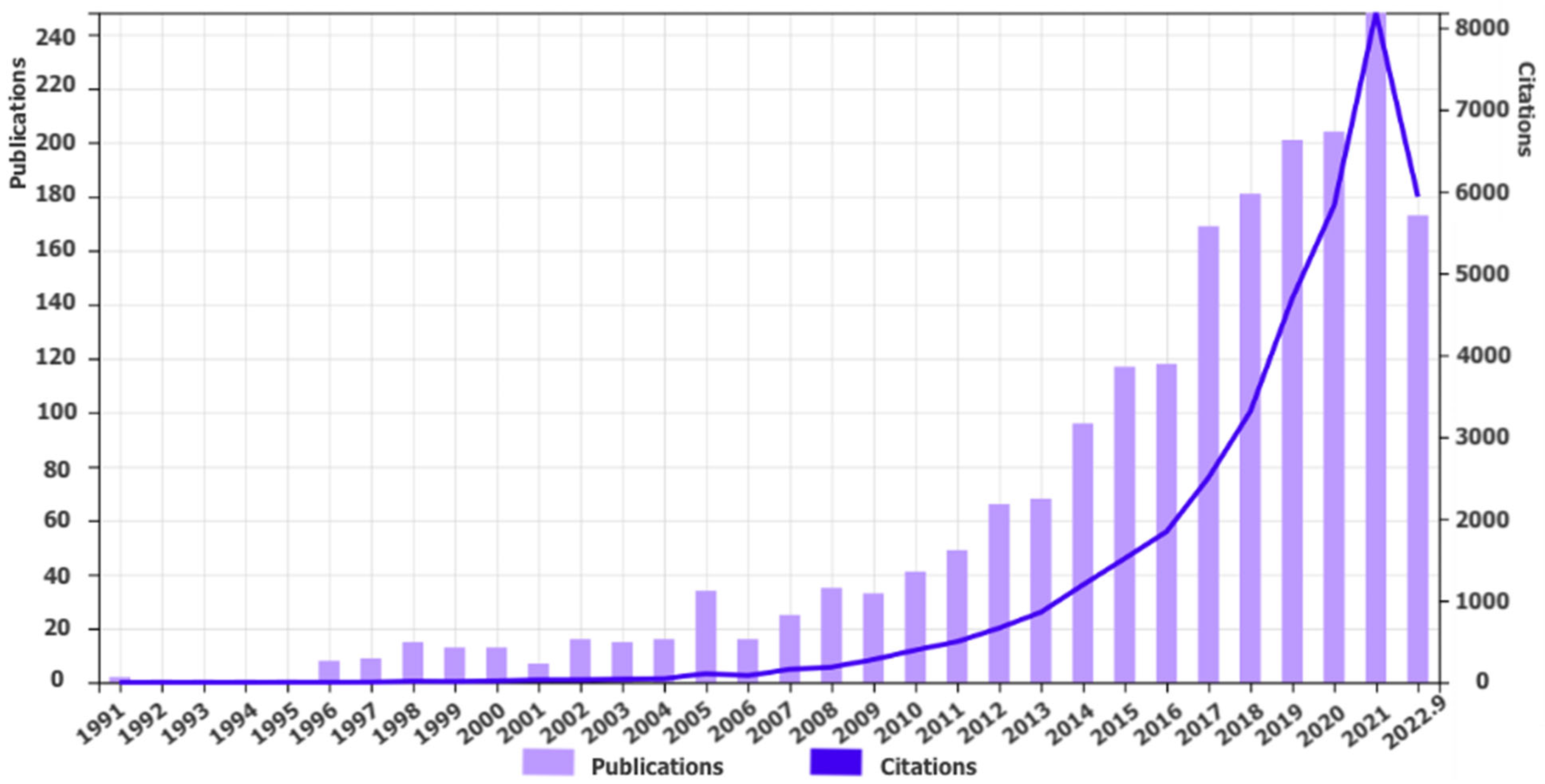
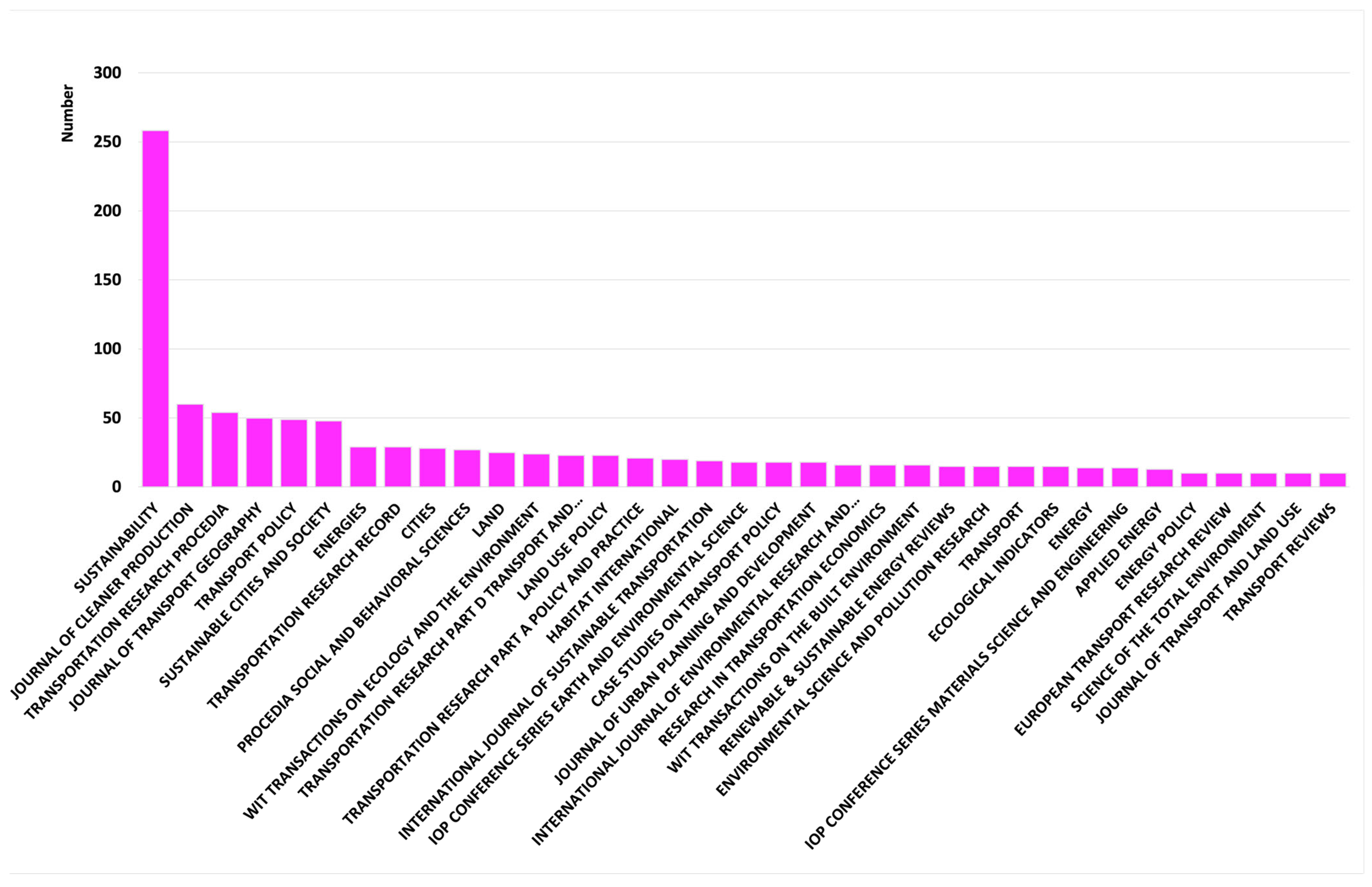
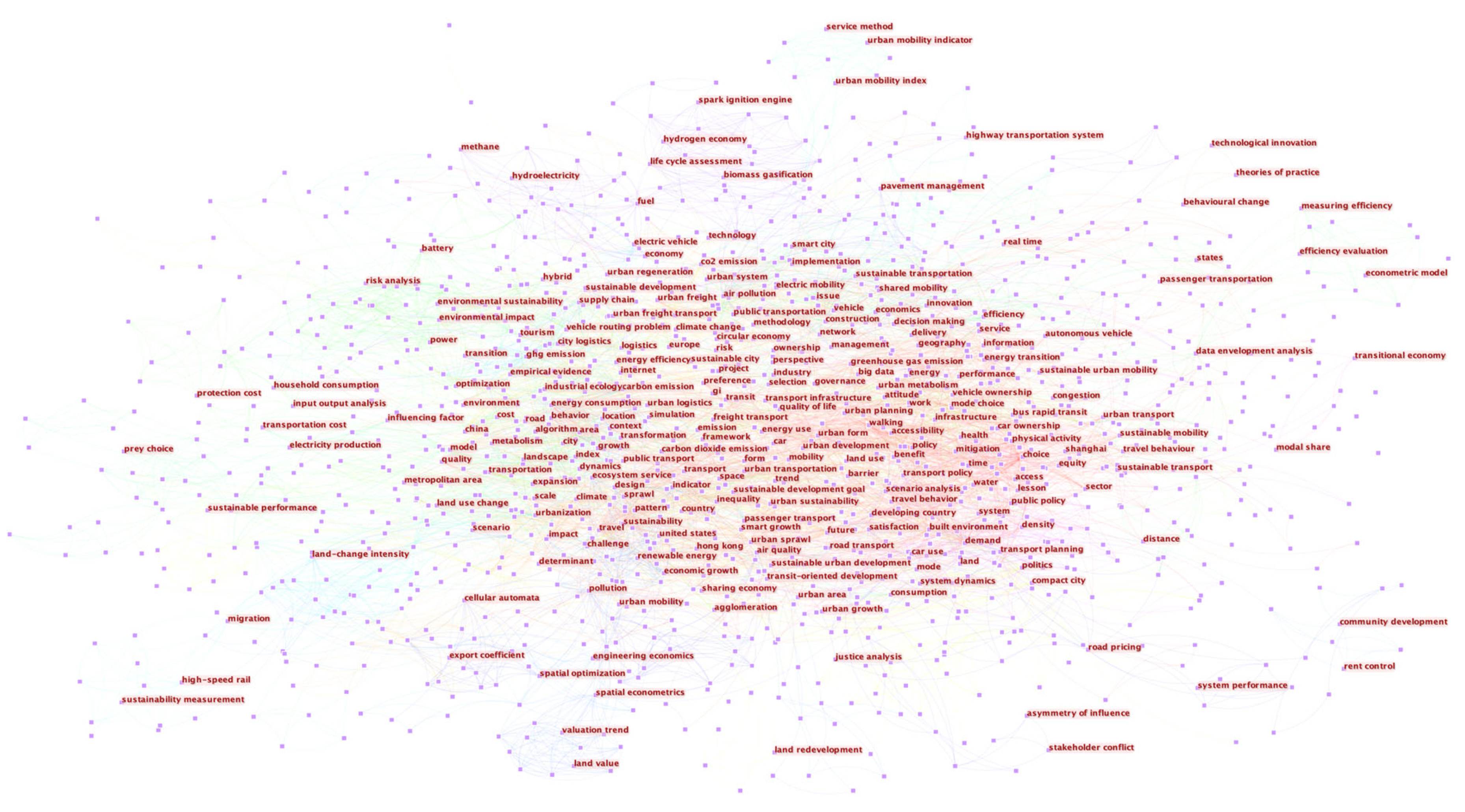
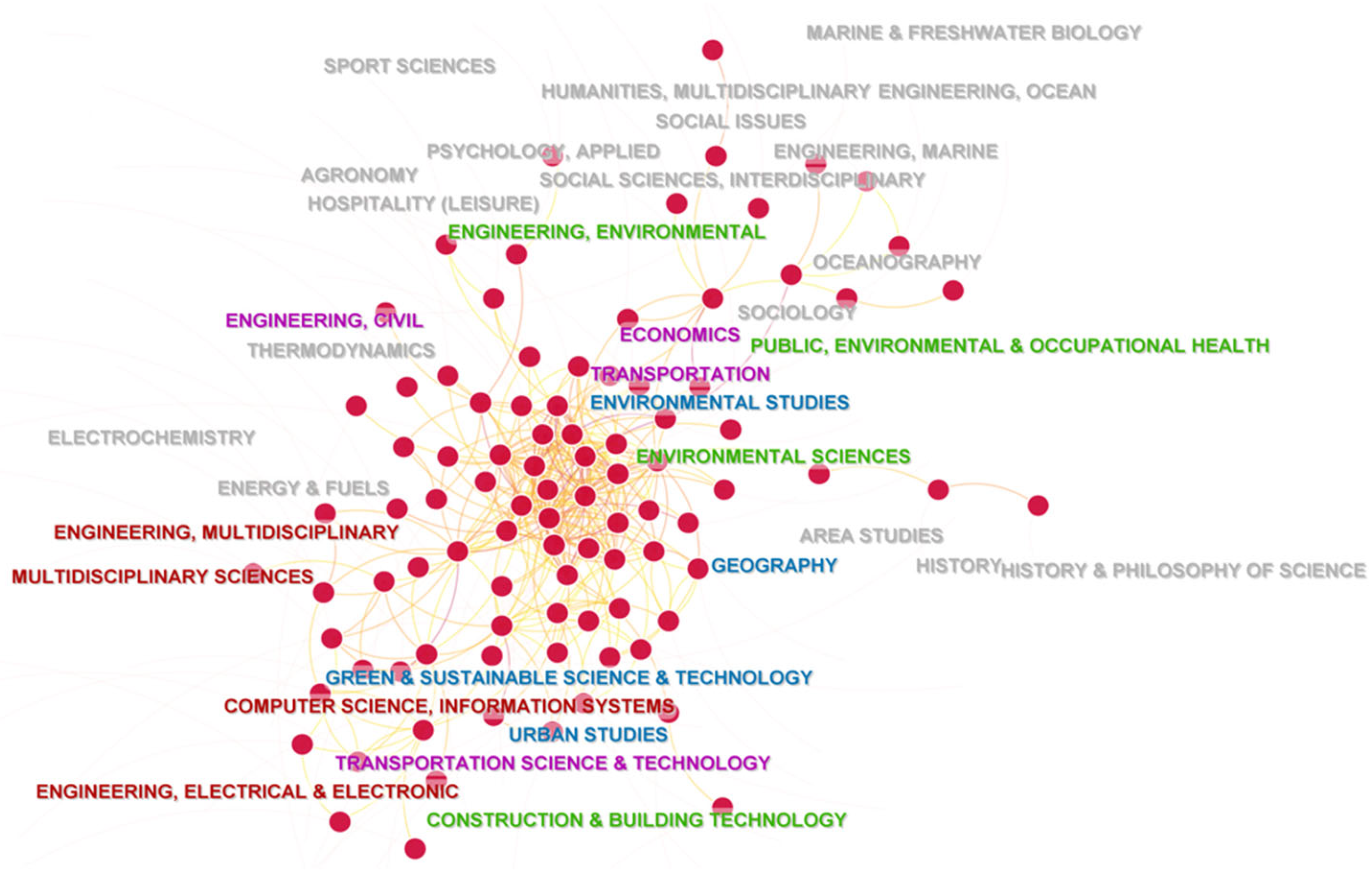

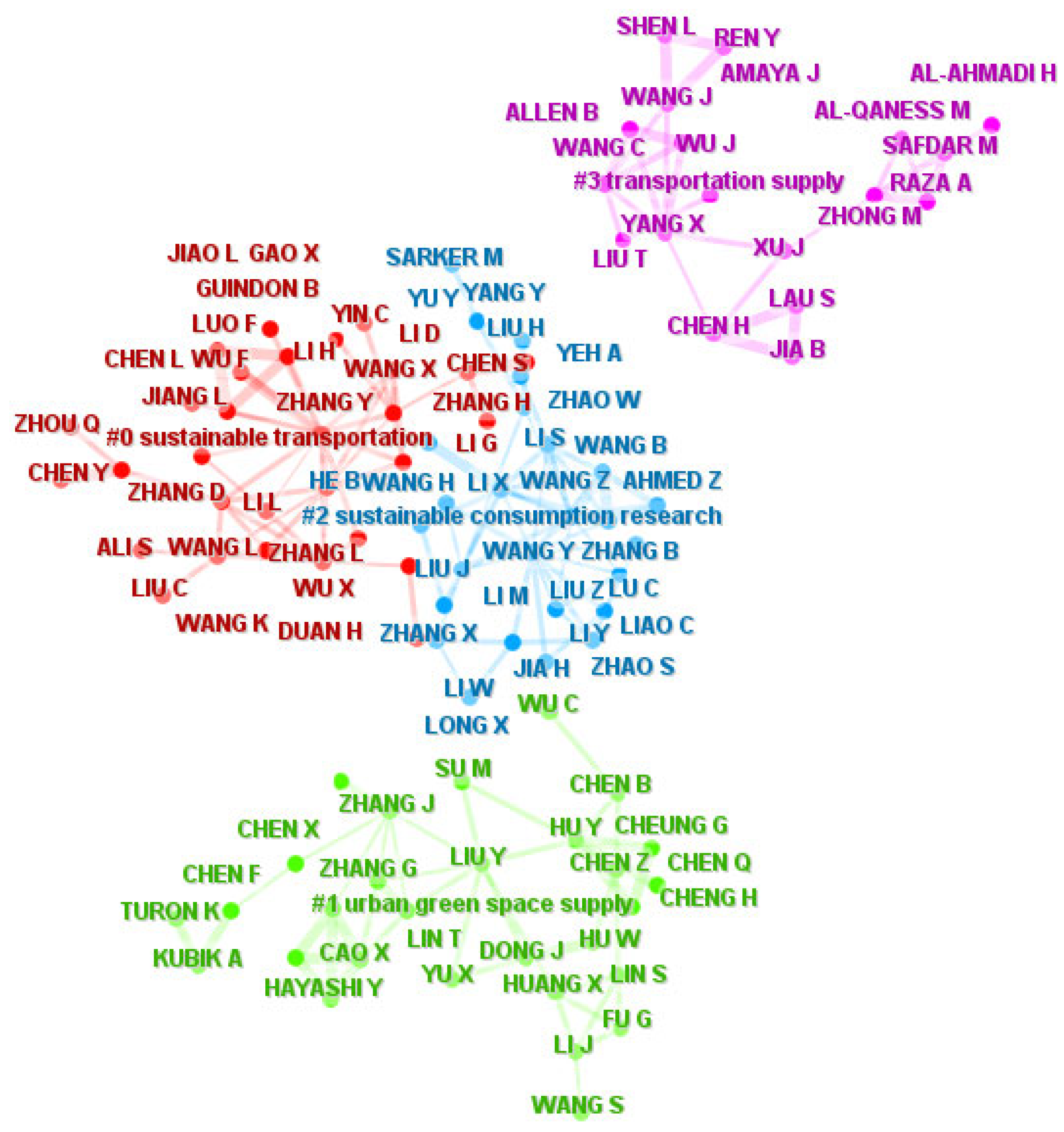

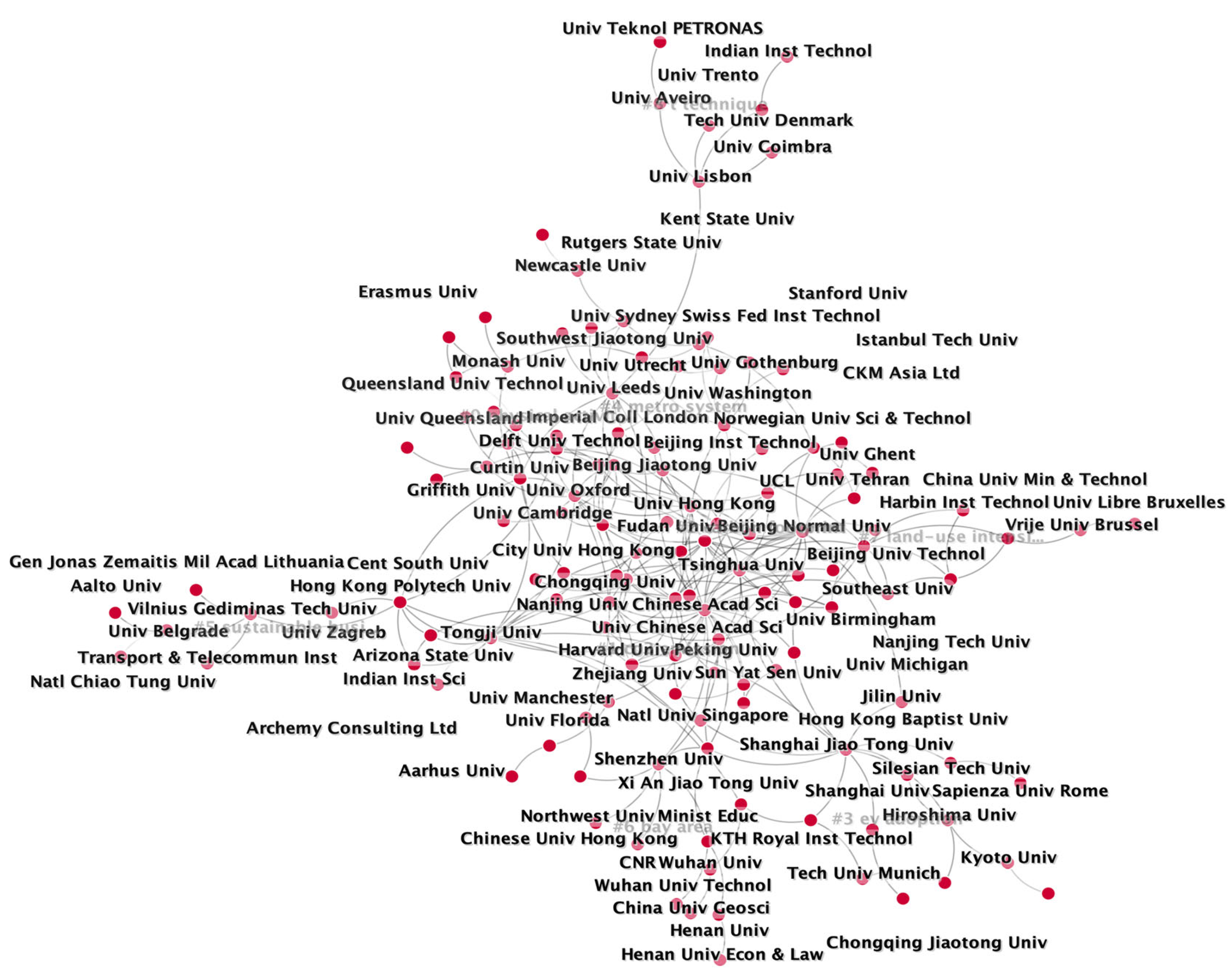

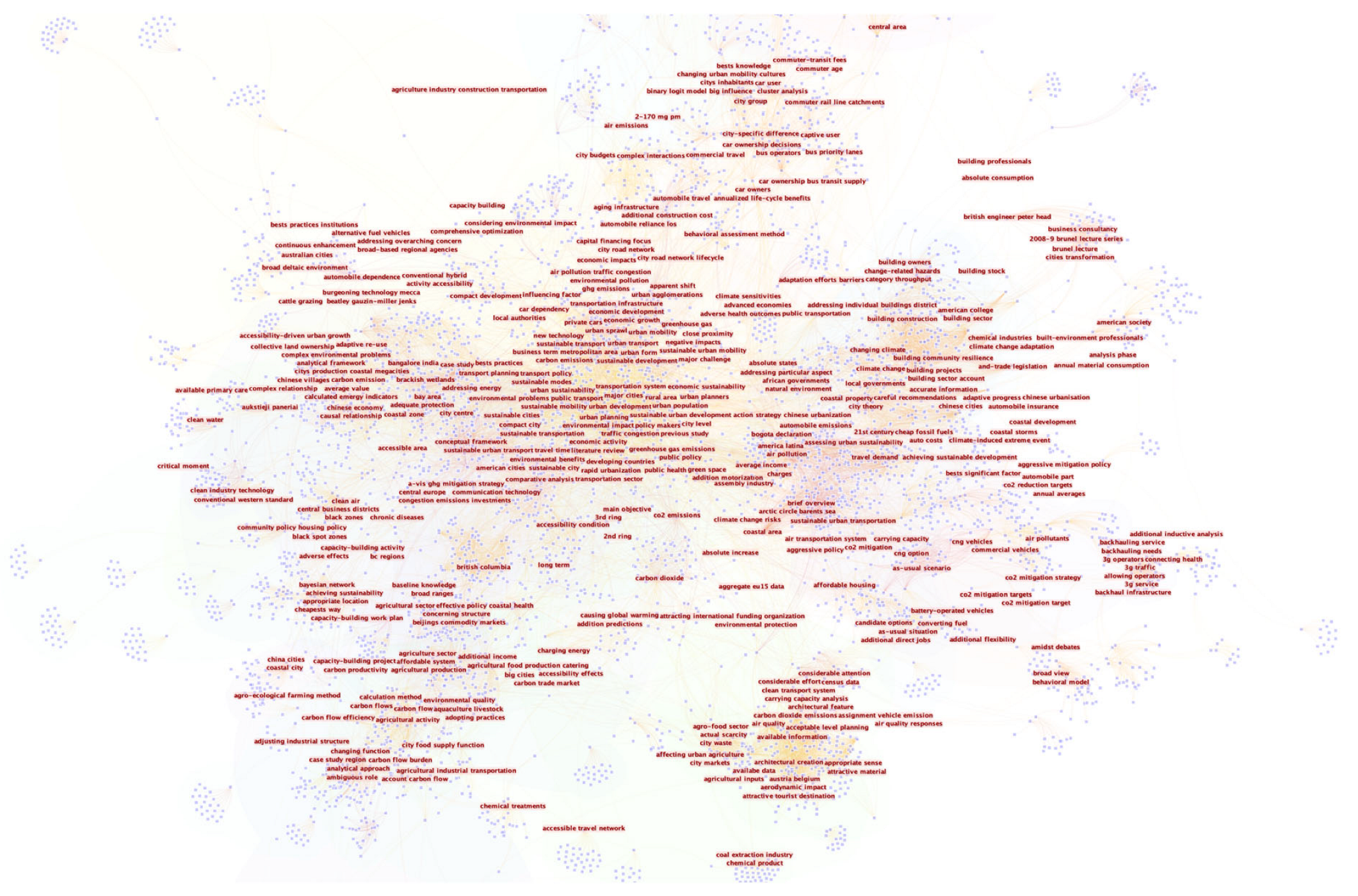
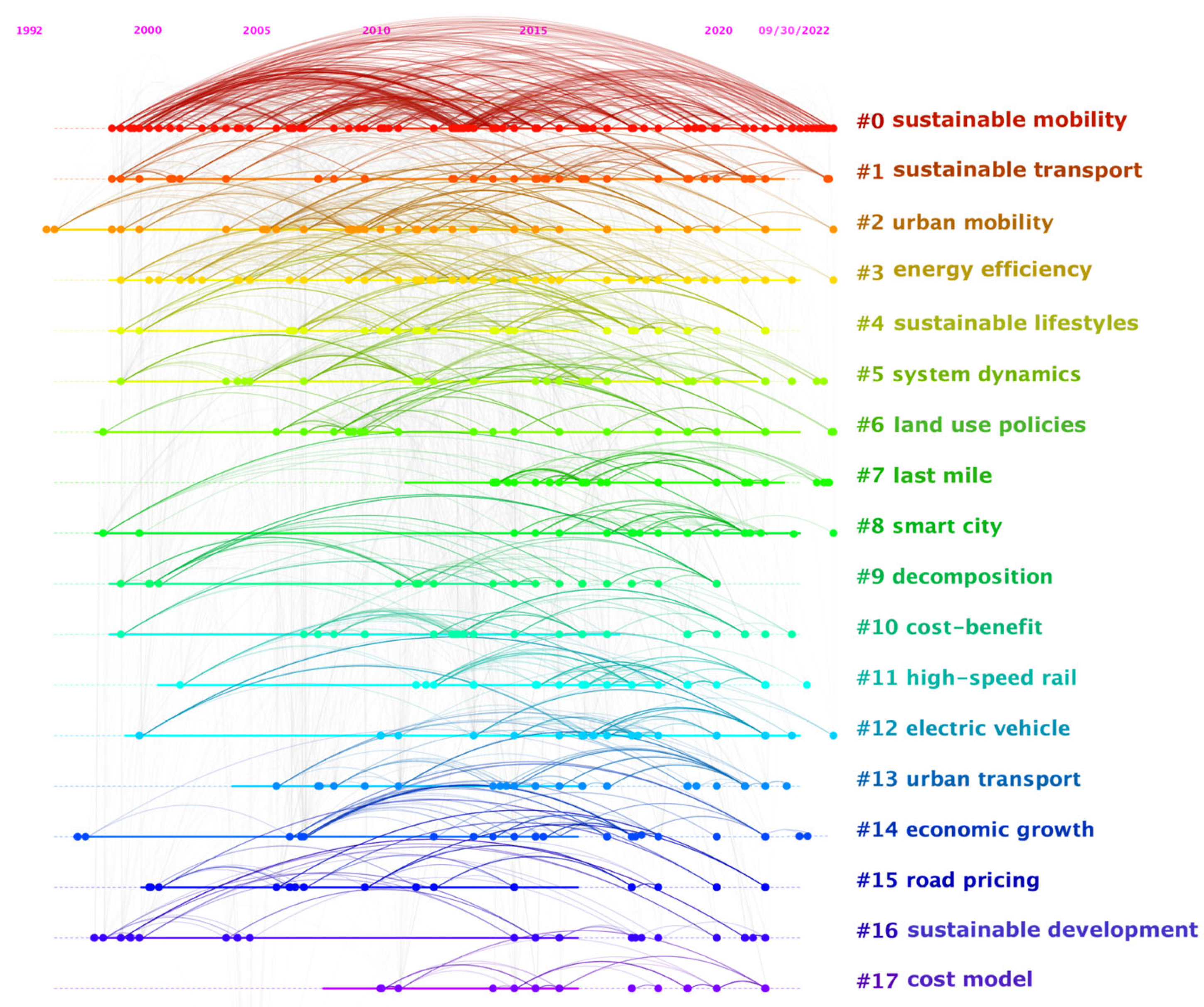
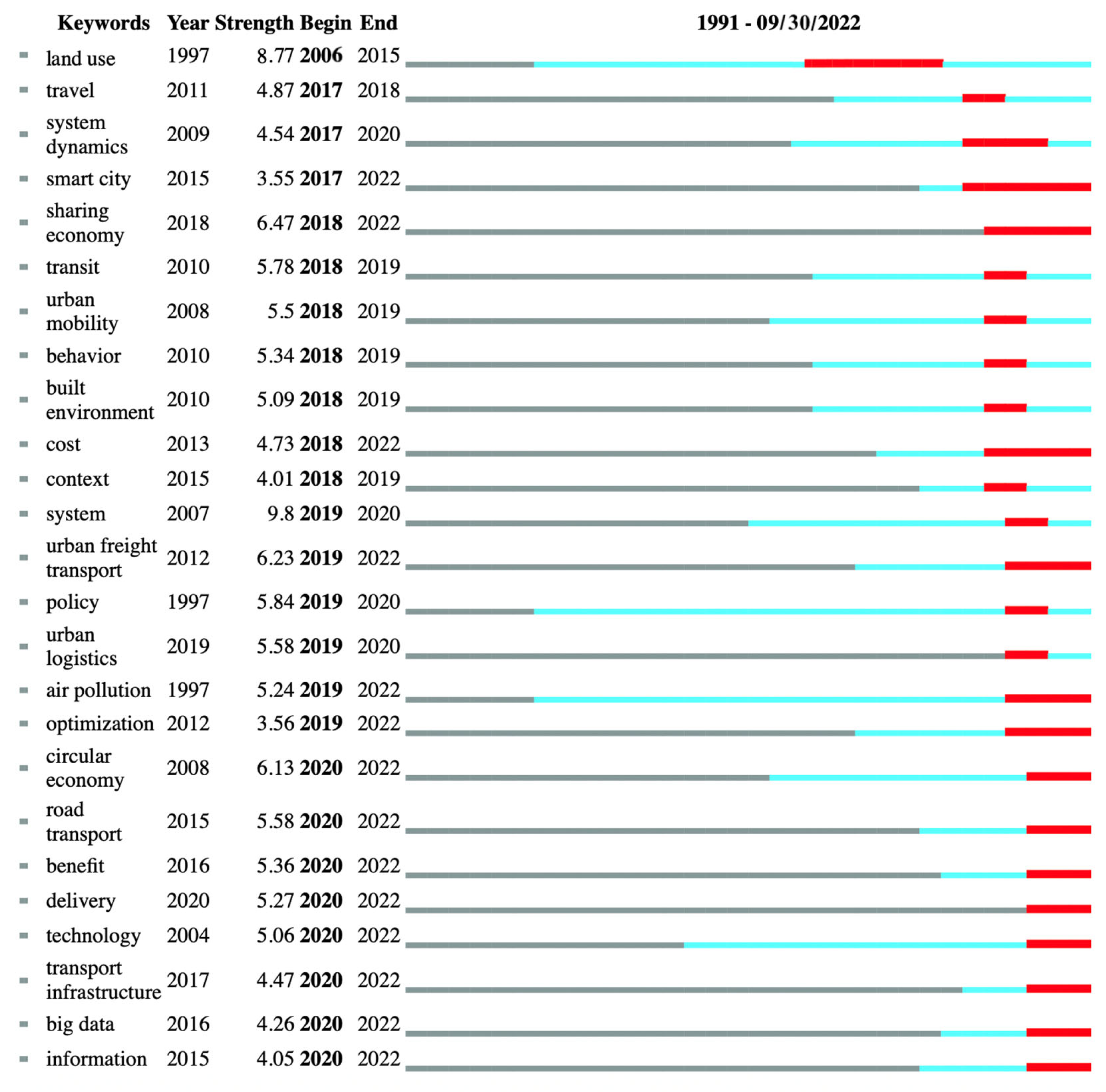
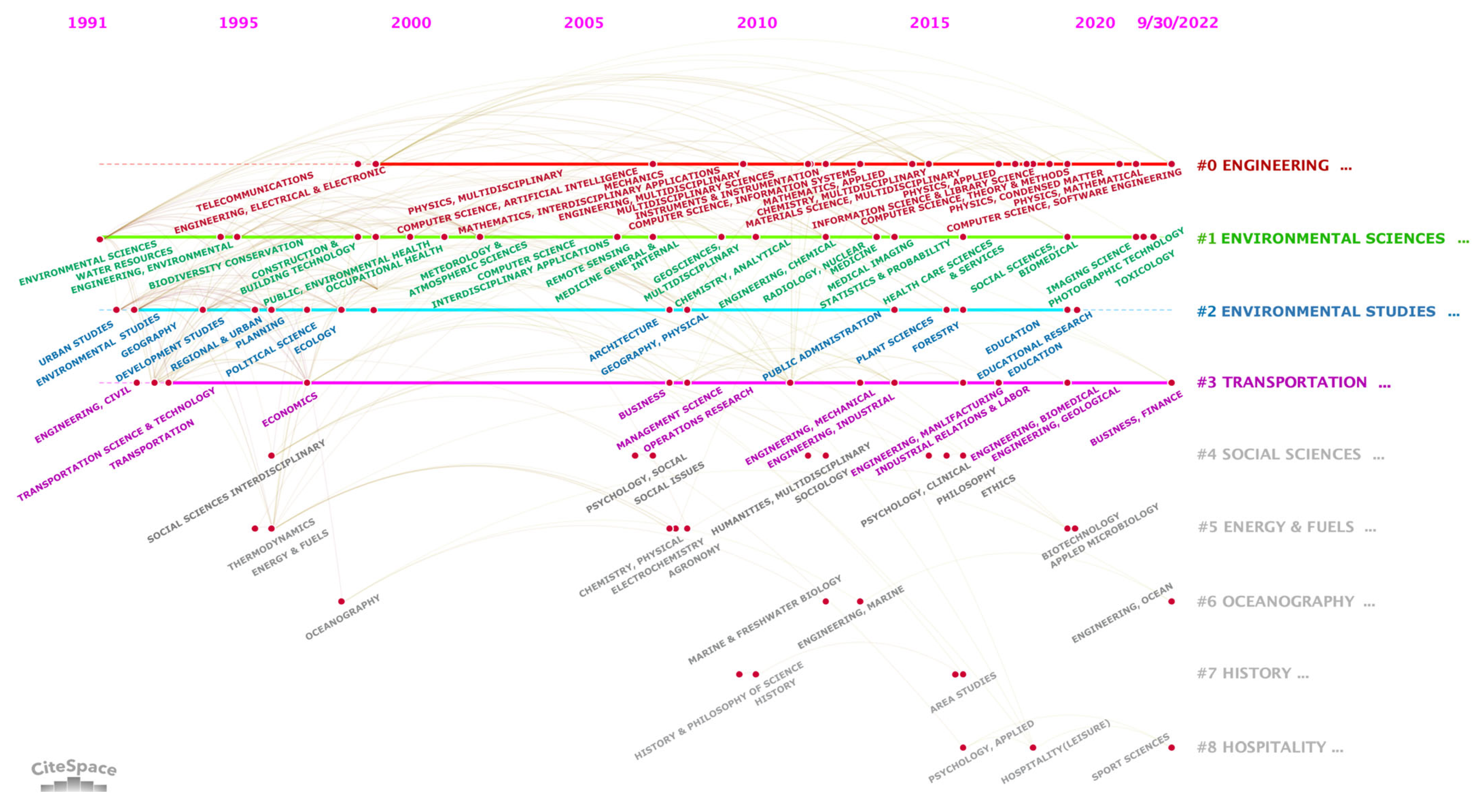
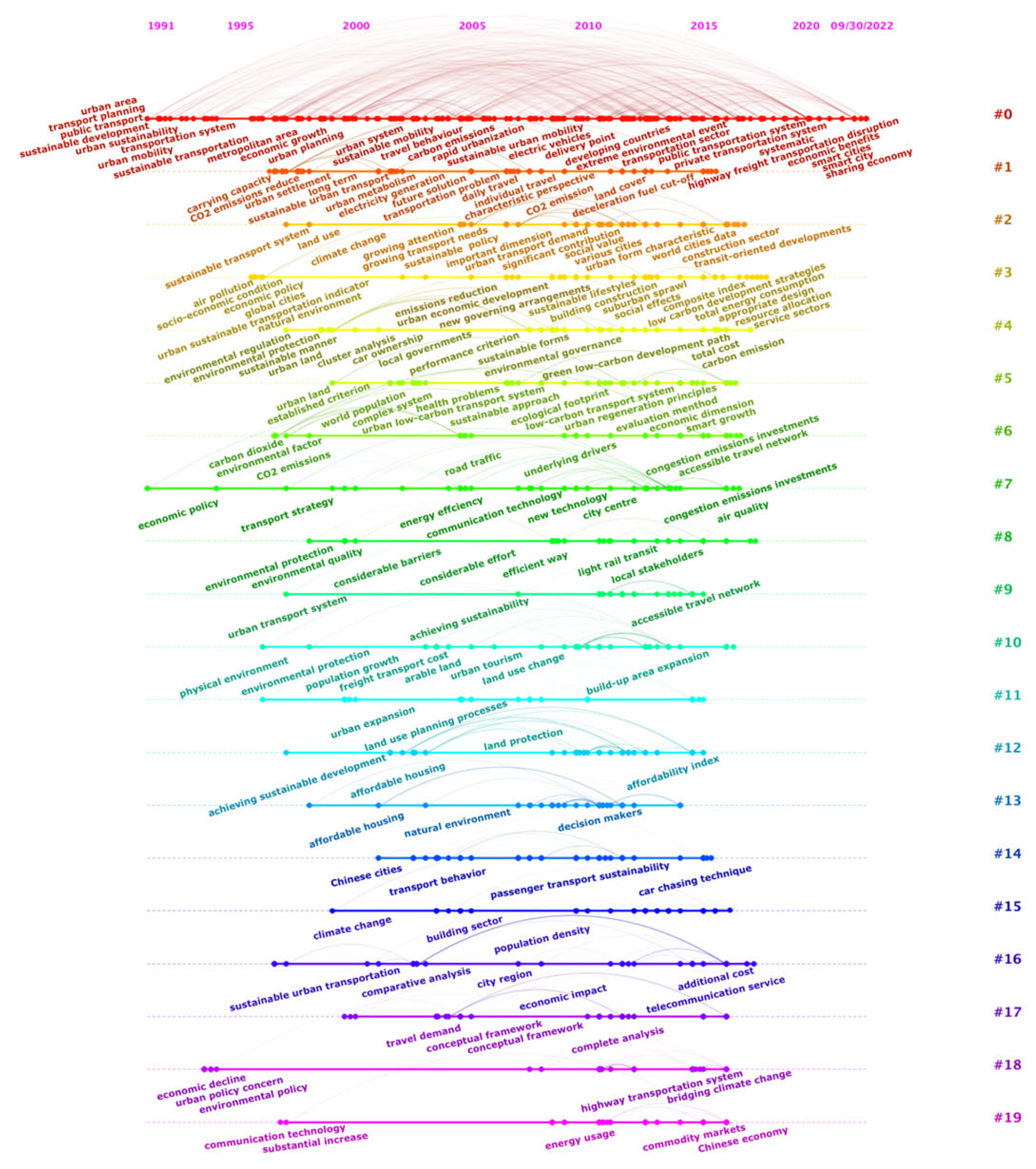
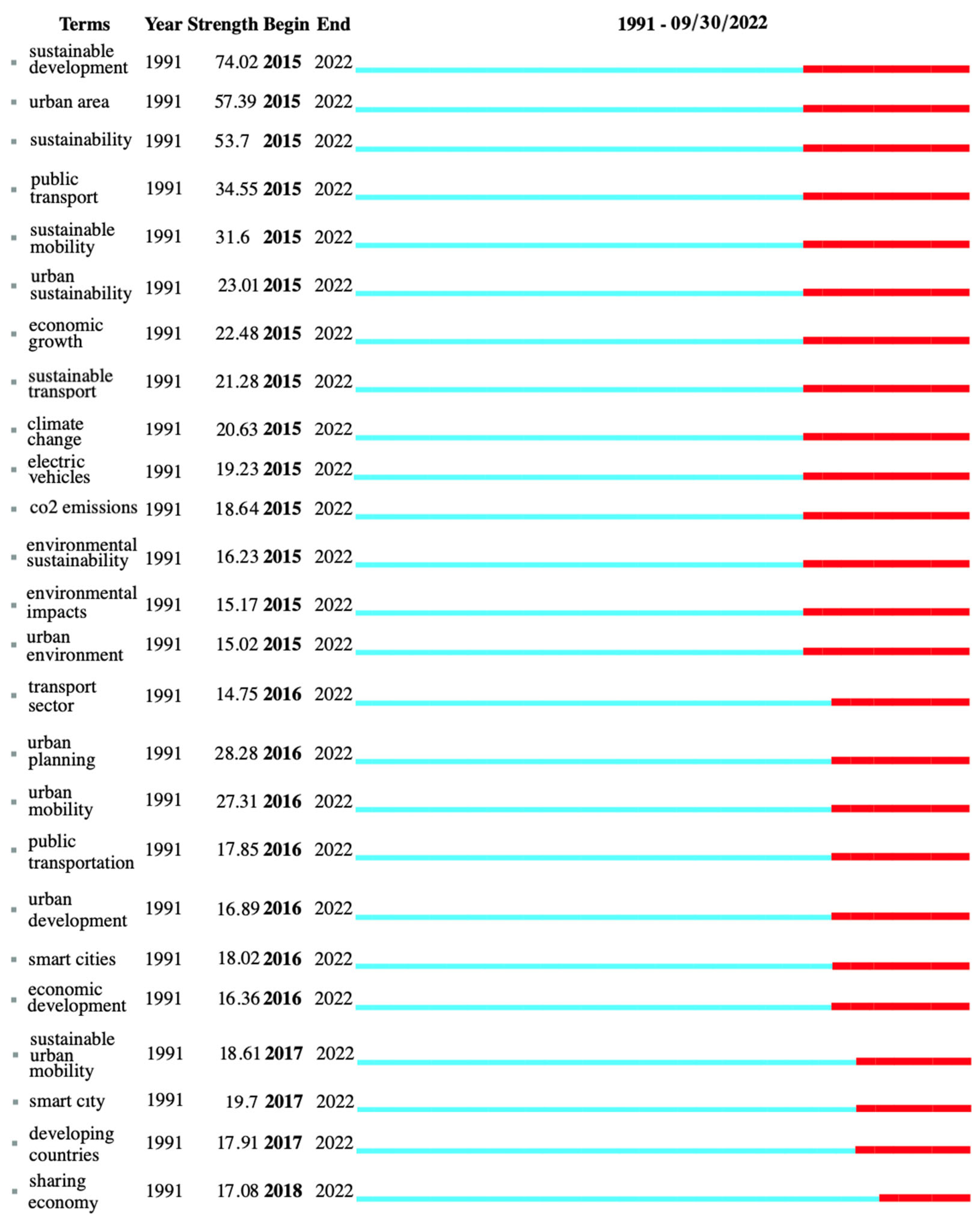
| No. | Institutions | Cited Institutional Articles | No. | Institutions | Cited Institutional Articles |
|---|---|---|---|---|---|
| 1 | Chinese Acad Sci | 49 | 16 | Univ Gdansk | 11 |
| 2 | Tongji Univ | 24 | 17 | Univ Chinese Acad Sci | 11 |
| 3 | Univ Oxford | 23 | 18 | Univ Sydney | 11 |
| 4 | Beijing Jiaotong Univ | 23 | 19 | Beijing Univ Technol | 10 |
| 5 | Beijing Normal Univ | 22 | 20 | Maritime Univ Szczecin | 10 |
| 6 | Tsinghua Univ | 19 | 21 | Southeast Univ | 10 |
| 7 | Univ Leeds | 18 | 22 | Peking Univ | 10 |
| 8 | Curtin Univ | 18 | 23 | Arizona State Univ | 10 |
| 9 | Vilnius Gediminas Tech Univ | 16 | 24 | Chongqing Univ | 10 |
| 10 | Univ Hong Kong | 15 | 25 | Monash Univ | 10 |
| 11 | Delft Univ Technol | 15 | 26 | Indian Inst Technol | 10 |
| 12 | UCL | 14 | 27 | Fudan Univ | 9 |
| 13 | Shanghai Jiao Tong Univ | 14 | 28 | Univ Cambridge | 9 |
| 14 | Univ Lisbon | 13 | 29 | Univ Belgrade | 9 |
| 15 | Vrije Univ Brussel | 12 | 30 | Harvard Univ | 9 |
Disclaimer/Publisher’s Note: The statements, opinions and data contained in all publications are solely those of the individual author(s) and contributor(s) and not of MDPI and/or the editor(s). MDPI and/or the editor(s) disclaim responsibility for any injury to people or property resulting from any ideas, methods, instructions or products referred to in the content. |
© 2023 by the authors. Licensee MDPI, Basel, Switzerland. This article is an open access article distributed under the terms and conditions of the Creative Commons Attribution (CC BY) license (https://creativecommons.org/licenses/by/4.0/).
Share and Cite
Bi, L.; Zhou, S.; Ke, J.; Song, X. Knowledge-Mapping Analysis of Urban Sustainable Transportation Using CiteSpace. Sustainability 2023, 15, 958. https://doi.org/10.3390/su15020958
Bi L, Zhou S, Ke J, Song X. Knowledge-Mapping Analysis of Urban Sustainable Transportation Using CiteSpace. Sustainability. 2023; 15(2):958. https://doi.org/10.3390/su15020958
Chicago/Turabian StyleBi, Lehua, Shaorui Zhou, Jianjie Ke, and Xiaoming Song. 2023. "Knowledge-Mapping Analysis of Urban Sustainable Transportation Using CiteSpace" Sustainability 15, no. 2: 958. https://doi.org/10.3390/su15020958
APA StyleBi, L., Zhou, S., Ke, J., & Song, X. (2023). Knowledge-Mapping Analysis of Urban Sustainable Transportation Using CiteSpace. Sustainability, 15(2), 958. https://doi.org/10.3390/su15020958





